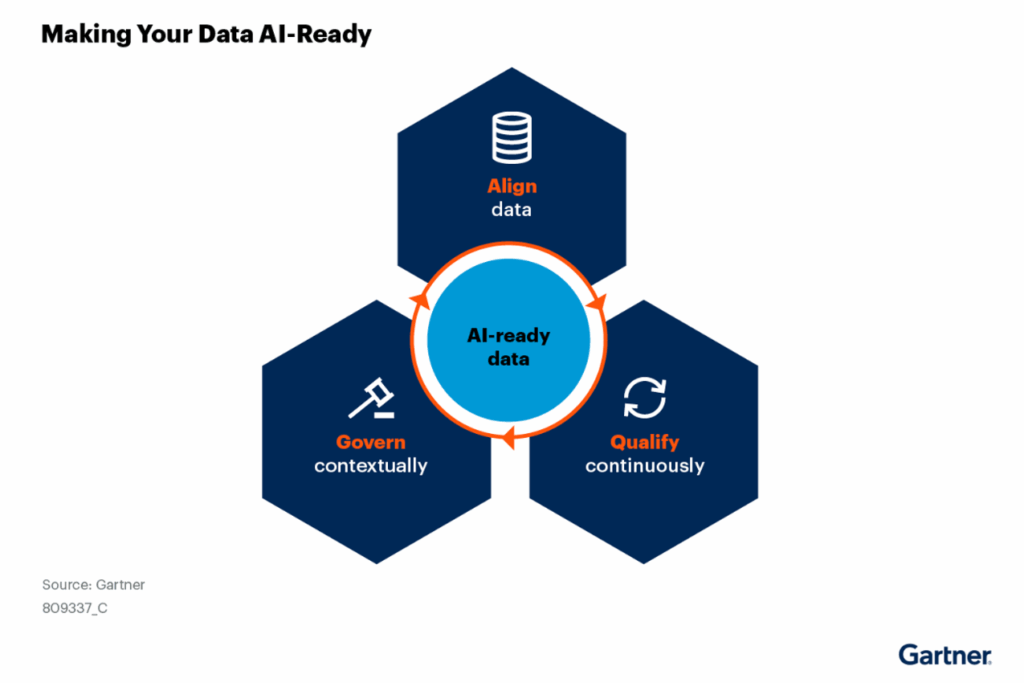As CIOs race to unlock the transformative potential of AI, a roadblock is emerging: ensuring that enterprise data is genuinely ready for AI use.
While the market for AI solutions is expanding quickly, many organizations are discovering that the real challenge lies not in choosing the right technology, but in preparing the right data.
Without AI-ready data, even the most sophisticated platforms will fall short of expectations.
Why AI-Ready Data Is the CIO’s New Priority
According to a recent Gartner survey, more than 75% of organizations cite AI-ready data as a top investment area for the next 2-3 years. This reflects a growing recognition that data is the foundation for every AI initiative, from chatbots and virtual assistants to advanced AI agents.
However, many CIOs and data leaders still approach data readiness with outdated assumptions, believing that traditional data quality and governance practices are sufficient for AI.
The reality is more nuanced.
Data readiness for AI is not a one-time project or a universal standard. It is a dynamic, iterative process that must be tailored to each use case and AI technique.
For AI, this means understanding not only what data is available, but whether it is truly fit for purpose.
Common Pitfalls in Preparing Data for AI
CIOs often encounter several pitfalls when preparing data for AI use:
- Assuming one-size-fits-all readiness: Data that is suitable for analytics or reporting may not be representative enough for AI training. For example, cleansing outliers for analytics can strip away the very anomalies that AI models need to learn from.
- Overemphasizing traditional data quality: High-quality data by conventional standards does not always translate to AI-ready data. AI models require exposure to errors, outliers, and unexpected patterns to perform accurately.
- Rigid governance expectations: While responsible governance is essential, AI use cases may require more flexible approaches. The principles for governing data in AI contexts can differ from those used in other domains.
- Underestimating unstructured data requirements: The rise of GenAI and large language models means organizations must rethink how they handle and prepare unstructured data, such as documents, emails, and chat logs.
These challenges underscore the need for CIOs to rethink their data management strategies and focus on the specific requirements of AI-ready data.
A Three-Step Framework for AI-Ready Data
To address these challenges, CIOs should adopt a three-step framework: align, qualify, and govern. Each step is crucial for ensuring that data can support AI solutions effectively.

1. Align Data with AI Use-Case Requirements
Every AI use case has unique data needs. CIOs must work closely with business and technical stakeholders to define what data is required, considering the specific AI technique being used.
For example, training a chatbot for customer service will need different data than building a virtual assistant for HR.
When preparing data for AI, CIOs must consider several factors that go beyond traditional data management. The requirements of the specific AI technique will dictate the type and structure of data needed. It is also important to quantify the available data, ensuring there is sufficient volume to train the model effectively, including historical and seasonal patterns; in cases where gaps exist, synthetic data may be necessary to supplement the dataset.
Semantics and labeling play a crucial role, as rich annotation, well-defined taxonomies, and comprehensive knowledge graphs are essential for enhancing model accuracy and enabling more advanced capabilities. The quality and trustworthiness of data are equally important; data must not only be complete and reliable, but also truly representative of the scenarios the AI will encounter in real-world use.
Finally, diversity and lineage must be addressed to support responsible AI development.
Avoiding bias in the data and maintaining transparency about data sources and transformations are critical steps to ensure fairness and accountability throughout the AI lifecycle.
“The quality and trustworthiness of data are equally important.”
2. Qualify Data for Confidence in AI Outcomes
Once data is properly aligned, CIOs must ensure it consistently meets the confidence requirements for AI use cases. This means regularly validating and verifying that the data fulfills necessary standards throughout both development and operational phases. Performance and cost metrics must also be considered, confirming that the data supports operational service level agreements such as response time and availability, while remaining cost-effective for inference.
Maintaining thorough versioning is essential, with detailed records of data versions, pipelines, and models to effectively manage drift and enable retraining when needed. Continuous regression testing is another critical practice, as it involves developing test cases to detect failures and data drift, helping to ensure that models remain accurate over time.
In addition, observability must be implemented through comprehensive metrics and monitoring to track the health, delivery, and accuracy of data, providing transparency and supporting ongoing reliability.
3. Govern Data Contextually for AI Use Cases
Effective governance forms the foundation for making data truly AI-ready.
CIOs need to establish and enforce governance policies that address the distinct risks and requirements associated with AI. This includes practicing data stewardship by applying appropriate policies throughout the entire data and model lifecycle, supported by strong observability measures. Compliance with evolving standards and regulations, such as the EU AI Act and GDPR, is essential, as these frameworks can significantly influence how data is managed and utilized.
Ethical considerations and fairness must also be prioritized, ensuring that questions around the appropriateness of training models on real customer data are thoughtfully addressed and that bias is actively mitigated. It is important to maintain control over inference and derivation by tracking how model outputs are used and combined, particularly within complex, composite AI systems.
Finally, promoting data sharing and the reuse of both data and metadata across various use cases is vital for accelerating AI readiness and fostering ongoing innovation.
What CIOs Should Do Now
To succeed with AI, CIOs must move beyond technology selection and focus on data readiness. This means:
- Collaborating with data and analytics leaders to map use-case requirements and identify data gaps.
- Investing in tools and processes for metadata management and observability.
- Establishing flexible governance frameworks that balance compliance, ethics, and innovation.
- Promoting data sharing and reuse to maximize the value of enterprise data assets.
AI promises to revolutionize business interactions, but its success depends on the quality and readiness of the underlying data. By adopting a contextual, iterative approach to data management, CIOs can ensure their organizations are prepared to meet the demands of AI-driven transformation.
The journey starts not with the next chatbot or virtual assistant, but with making data truly AI-ready.
Trusted insights for technology leaders
Our readers are CIOs, CTOs, and senior IT executives who rely on The National CIO Review for smart, curated takes on the trends shaping the enterprise, from GenAI to cybersecurity and beyond.
Subscribe to our 4x a week newsletter to keep up with the insights that matter.







